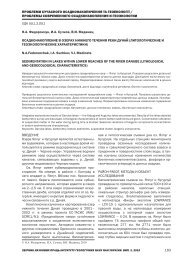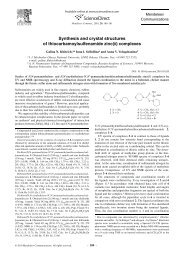study of yeast biota of coastal surface waters of zmiinyy island
study of yeast biota of coastal surface waters of zmiinyy island
study of yeast biota of coastal surface waters of zmiinyy island
You also want an ePaper? Increase the reach of your titles
YUMPU automatically turns print PDFs into web optimized ePapers that Google loves.
3 rd Ukrainian-Polish Weigl Conference<br />
„Microbiology on Service for Human”<br />
Odesa, Odesa National I.I. Mechnykov University<br />
14-17 September 2009<br />
STUDY OF YEAST BIOTA<br />
OF COASTAL SURFACE WATERS OF ZMIINYY ISLAND:<br />
ECOLOGICAL AND MICROBIOLOGICAL ASPECTS<br />
BILOIVANENKO S.O., IVANYTSYA V.O.,<br />
BUCHTIYAROV A.YE., LISYUTIN G.V.<br />
I.I. Mechnikov Odesa National University 2, Champansky Side Street, Odesa, 65058,<br />
Ukraine, e-mail: serch2007@rambler.ru<br />
Yeasts are important and integral components <strong>of</strong> marine biogeocenosis because they are involved in various<br />
function control <strong>of</strong> the biosphere. Zmiinyy Island is situated in the traverse <strong>of</strong> the most important water<br />
streams <strong>of</strong> Europe. Its <strong>coastal</strong> <strong>waters</strong> are the place <strong>of</strong> transformation and accumulation <strong>of</strong> altered micro<strong>biota</strong><br />
incoming from the main European river Danube, that contains the sewage water <strong>of</strong> 18 European countries.<br />
Thereby, the relevance <strong>of</strong> population dynamic and biodiversity <strong>study</strong> <strong>of</strong> such poorly investigated group <strong>of</strong> microorganisms<br />
as marine <strong>yeast</strong>s is important and indisputable.<br />
Aim. The main goal <strong>of</strong> the present <strong>study</strong> was quantitative and qualitative (species composition) evaluation<br />
<strong>of</strong> the <strong>yeast</strong> population <strong>of</strong> <strong>of</strong>fshore strip seawater <strong>of</strong> Zmiinyy Island, Ukraine. Also, we have tried to determine<br />
the peculiarities <strong>of</strong> potentially pathogenous <strong>yeast</strong>s distribution and to establish dominant species into investigated<br />
marine <strong>yeast</strong> population.<br />
The objects <strong>of</strong> <strong>study</strong> were marine <strong>yeast</strong>s isolated from superficial biotope <strong>of</strong> <strong>coastal</strong> <strong>waters</strong> <strong>of</strong> Zmiinyy<br />
Island.<br />
Materials and methods. Seawater sampling was undertaken during one <strong>of</strong> the last expeditions to Zmiinyy<br />
Island in May 2009. Eight samples <strong>of</strong> <strong>surface</strong> seawater were aseptically collected from different sites located<br />
around the <strong>island</strong>. The main peculiarities <strong>of</strong> water regime and presence <strong>of</strong> possible infection source have been<br />
considered [4]. For the isolation <strong>of</strong> <strong>yeast</strong>s, 0.1–0.5 ml <strong>of</strong> native sample <strong>of</strong> seawater was directly spread on Petri<br />
dish with Sabouraud’s medium containing 10.0 g <strong>of</strong> casein hydrolyzate, 40.0 g <strong>of</strong> dextrose, 15.0 g <strong>of</strong> agar and<br />
supplemented with 0.1% <strong>of</strong> chloramphenicol [1, 3].The cultivation was performed at 20–22 0 Ñ for 2 days. The<br />
morphological characteristics, physiological and biochemical properties <strong>of</strong> the <strong>yeast</strong> isolates were routinely examined.<br />
Taxonomic identification procedures <strong>of</strong> isolated <strong>yeast</strong>s were performed as recommended by Kreger-van Rij<br />
(1984), Kurtzman and Fell (1998) [6, 7]. The frequency <strong>of</strong> each <strong>yeast</strong> species was calculated. The data were<br />
conventionally analyzed for statistically significant differences. P values < 0.05 were considered as significant.<br />
Results. In the present <strong>study</strong> the density <strong>of</strong> isolated <strong>yeast</strong> population formed from 10 to 31 colony forming<br />
units/ml (CFU/ml), whereas average <strong>yeast</strong> number was 15 CFU/ml. The distribution <strong>of</strong> <strong>yeast</strong>s in studied population<br />
was sufficiently homogeneous, that can be explained by high intensity <strong>of</strong> <strong>surface</strong> <strong>coastal</strong> seawater mixing.<br />
Also, it is evidently that saltiness and temperature conditions are not baleful for living and active development <strong>of</strong><br />
these marine <strong>yeast</strong>s.<br />
In this <strong>study</strong>, a total <strong>of</strong> 5 genera <strong>of</strong> <strong>yeast</strong>s were identified. Prevailing species <strong>of</strong> <strong>yeast</strong>s were Cryptococcus<br />
albidus, C. ne<strong>of</strong>ormans, Aerobasidium pullulans, Candida albicans, Rhodotorula rubra, R. glutinis,<br />
Rhodosporidium paludigenum. All <strong>of</strong> them are typical cosmopolites and commonly widespread in various<br />
natural environments.<br />
The water areas <strong>of</strong> the Black Sea, that were immediately close by slopping ground coast <strong>of</strong> the <strong>island</strong>,<br />
demonstrated the most expressed density <strong>of</strong> isolated <strong>yeast</strong> population (e.g., 31 CFU/ml in the moorage zone),<br />
because they are usually characterized by abundance <strong>of</strong> various organic nutrients that are supplied during<br />
atmospheric precipitation. Moreover, the results obtained suggest some fidelity <strong>of</strong> A. pullulans to these areas.<br />
At the same time the water areas which contact with a rock-ribbed coast demonstrated the lowest values <strong>of</strong><br />
<strong>yeast</strong> population density (e.g., only 10 CFU/ml in the water area <strong>of</strong> Damsjkyy beach).<br />
It is well known that potentially pathogenous (opportunistic) <strong>yeast</strong>s, widespread in various environmental<br />
33
habitats, are capable <strong>of</strong> causing mycoses in humans and animals. The evidence <strong>of</strong> our experiments also suggests<br />
active natural circulation <strong>of</strong> such pathogenous <strong>yeast</strong>s as C. albidus, C. ne<strong>of</strong>ormans and C. albicans, that have<br />
been quite frequently isolated from seawater samples (the frequency <strong>of</strong> occurrence was approximately 43.0 %).<br />
The population peak <strong>of</strong> C. albidus was only 7.5%, whereas in C. ne<strong>of</strong>orman and C. albicans this index has<br />
reached 24.7 and 40.5 % respectively. Such variation <strong>of</strong> percentage pathogenous <strong>yeast</strong> composition probably<br />
can be associated first <strong>of</strong> all with sea<strong>waters</strong> circulation direction.<br />
It is important to emphasize that two species <strong>of</strong> <strong>yeast</strong>s – A. pullulans and R. rubra were significantly<br />
predominant in examined <strong>yeast</strong> population. So, the observed frequency <strong>of</strong> black <strong>yeast</strong> A. pullulans occurrence<br />
was 54.1 %, and pink <strong>yeast</strong> R. rubra occurrence – 34.1 %. This phenomenon <strong>of</strong> dominance <strong>of</strong> black and pink<br />
species in general <strong>yeast</strong> population is common for various water ecosystems, indeed conditions <strong>of</strong> marine environment<br />
are seemed to be optimal for living <strong>of</strong> two aforementioned <strong>yeast</strong> species in their ecological niches.<br />
Conclusions. Firstly, the main peculiarities <strong>of</strong> marine <strong>yeast</strong>s space distribution <strong>of</strong> <strong>coastal</strong> <strong>surface</strong> <strong>waters</strong><br />
<strong>of</strong> Zmiinyy Island have been described. Summing up, the findings in this <strong>study</strong> show that isolated <strong>yeast</strong>s characterized<br />
by zonality <strong>of</strong> their distribution depended on source <strong>of</strong> organic substances arrival into seawater. Frequent<br />
occurrence <strong>of</strong> opportunistic <strong>yeast</strong>s into superficial <strong>waters</strong> demonstrates their rapid adaptation to marine environment.<br />
Moreover, the absolute prevalence <strong>of</strong> two pigment-containing species among all <strong>yeast</strong> isolates indicate the<br />
most expressed adaptability <strong>of</strong> these <strong>yeast</strong>s to the conditions <strong>of</strong> this marine ecosystem.<br />
This work was supported by the Ministry <strong>of</strong> Education and Science <strong>of</strong> Ukraine (grants no. ÇÌ/321-2008<br />
and ÄÇ/300-2008).<br />
References.<br />
1. Babjeva I.P., Golubev V.I. Yeast isolation and identification methods. – Moscow: Pischevaya<br />
promyshlennostj, 1979. (In Russian).<br />
2. Berry N., Davis R. Yeast biology. – Moscow: Mir, 1985. – 157 c. (In Russian).<br />
3. Golubcev V.B. Taxonomy and identification <strong>of</strong> <strong>yeast</strong>s <strong>of</strong> genus Cryptococcus. – Moscow: Mir,<br />
1990. – 321 c. (In Russian).<br />
4. Kvasnikov L.N. The Yeasts. – Kiev: Naukova dumka, 1998. – 264 c. (In Russian).<br />
5. Kvasnikov L.N., Schelokova I.F. The Yeasts. Biology. Directions <strong>of</strong> application. – Kiev: Naukova<br />
dumka, 1991. (In Russian).<br />
6. The <strong>yeast</strong>s. A taxonomic <strong>study</strong>. Ed. N.J.W. Kreger-van Rij. Third edition. Amsterdam: Elsevier,<br />
1984, 1082 p.<br />
7. The <strong>yeast</strong>s. A taxonomic <strong>study</strong>. Eds. C.P. Kurtzman, J.W. Fell. Fourth revised and enlarged edition.<br />
Amsterdam: Elsevier Science B.V., 1998, 1055 p.<br />
34
















